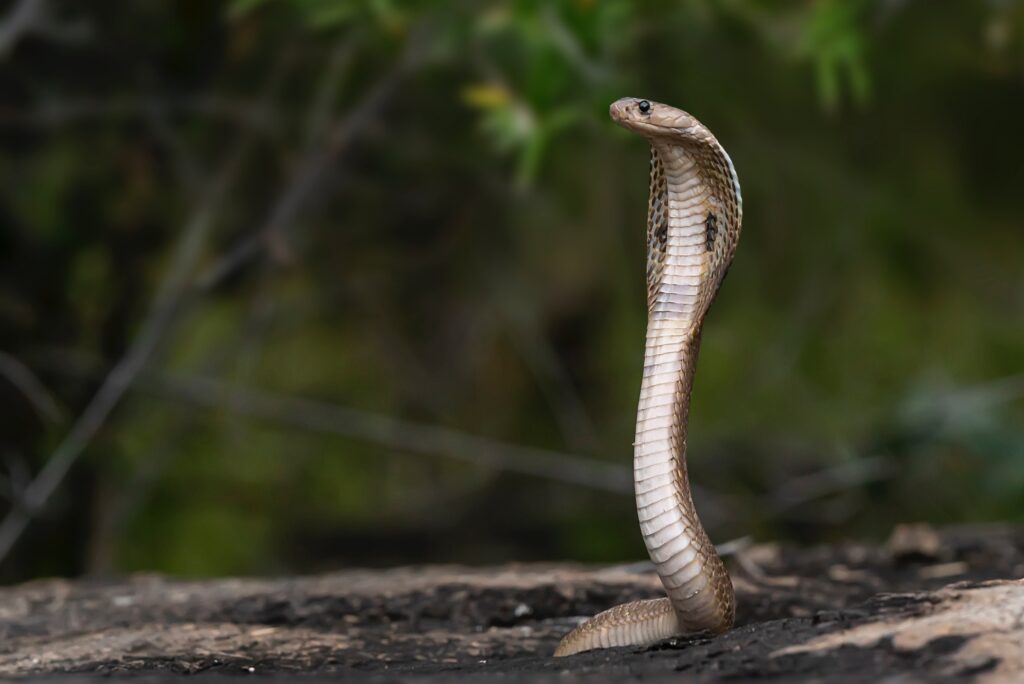
A photo of an Indian Cobra by Nivedh P from Unsplash
CEBU CITY, Philippines — On July 8, 2023, Vince Saz from San Fernando, Cebu shared on social media about his and his friends’ encounter with a cobra in a mountainous area of the town.
He told CDN Digital that it was their first time to see a cobra in the area. Fortunately, no one was harmed.
Snake bites
According to the Department of Health (DOH), while there are snakes that are fatal, the majority of snakes are not venomous.
There are two types of snake bites: dry and venomous.
Dry bites come mostly from non-venomous snakes and these happen when snakes do not secrete venom when they bite.
Among the non-venomous snakes are Rough Green Snake, Common Garter Snake, and Python.
Venomous bites, on the other hand, are more threatening as these happen when snakes inject venom when they bite.
READ MORE: King Cobra captured in Tabogon, Cebu
Venom is a poisonous substance emitted by species like snakes, scorpions, or bees.
Cobras are among the snake kinds that are venomous.
DOH noted that a snake bite is a “medical emergency,” which can also cause hospital admission.
“It may result in the death or chronic disability of many active younger people, especially those involved in farming and plantation work, if not given immediate treatment,” the agency said in a post.
And even if the bite is not that serious, it should be treated as a medical emergency because delaying the treatment could result in a worst-case scenario like death.
What you should do when bitten by a snake
The health agency said that first aid treatment should be carried out as soon as possible when bitten by a snake before the patient reaches the hospital.
The next thing to do is to reassure the patient in case they are anxious about the situation, then immobilize their body by laying them down in a comfortable and safe position.
Additional reminders
DOH also noted to immobilize the bitten limb with a splint or sling and apply pressure to the affected part if necessary.
It is also important to avoid any “interference with the bite wound” such as incisions, rubbing, vigorous cleaning, massage, and application of herbs or chemicals” as these may “introduce infection, increase absorption of the venom, and increase local bleeding.”
Moreover, there are also things that you should avoid doing, according to the DOH:
- Do not make the patient tired.
- Do not use a tourniquet.
- Do not use ice packs on the bite marks.
- Do not puncture, pinch, or scrape bitten area.
- Do not suck in venom from the patient’s open wound.
- Do not give medication not prescribed by the doctor.
- Do not elevate the wound at the same level or higher than the chest or heart area.
DOH said that “antivenom is the only effective antidote for snake venom.”
Purified Cobra Antivenin
In the Philippines, there is only one known antidote for snake venom—the Purified Cobra Antivenin (PCAV) by the Research Institute for Tropical Medicine (RITM)
PCAV has been the “only known antidote” or antitoxin effective for snake bites, which are specifically caused by Philippine Cobra (Naja philippinensis) since the 1960s in the Philippines.
The farmers from Bicol and Nueva Ecija are usually the recipients of PCAV. These are the places that have a high number of recorded cases of snakebites. /rcg
RELATED STORIES:
Netizens on cobra spotted in San Fernando, Cebu: ‘Kahadlok!’
Brazilian viper venom may become tool in fight against coronavirus, study shows
Indonesian singer dies after being bitten by a cobra while performing
Sources:
Snake Bites – Cleveland Clinic
Purified Cobra Antivenom (PCAV): How is it made?
Department of Health (Philippines)
